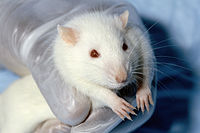
Photo from wikipedia
Aging is the single most important cause of disease, disability, and death in companion animal species. Contrary to the common view of aging as mysterious and inevitable, it is more… Click to show full abstract
Aging is the single most important cause of disease, disability, and death in companion animal species. Contrary to the common view of aging as mysterious and inevitable, it is more usefully understood as a set of complex but comprehensible and modifiable biological processes that are highly conserved across species. The purpose of this Currents in One Health manuscript is to describe key mechanisms of aging at the cellular and molecular level and the manifestations of these in the tissues of the musculoskeletal system, adipose, and the brain. The characteristics of these processes as identified in common laboratory animal models and in humans will be described and compared with the much more limited information available concerning aging in dogs and cats. This will highlight important targets for future research in these species. The consistent patterns across species in the hallmarks of aging and their manifestations at the level of tissues, organ systems, and individual animals signify potential targets for interventions to mitigate the negative health impacts of aging and extend both life span and health span (the period of life free of significant disease or disability). Further research to elucidate aging mechanisms in companion dogs and cats will eventually support development, testing, and implementation of clinical therapies to prevent and ameliorate age-related dysfunction, disease, and death.
Journal Title: American journal of veterinary research
Year Published: 2022
Link to full text (if available)
Share on Social Media: Sign Up to like & get
recommendations!